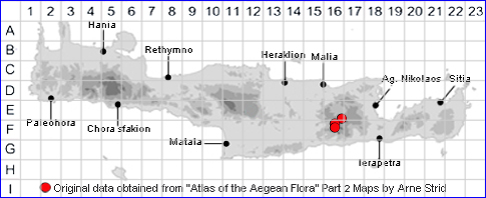
SILENE MULTICAULIS subsp. MULTICAULIS
Family and Genus:- See- CARYOPHYLLACEAE/Sect. SPERGULIFOLIAE
Common Names:- None
Homotypic Synonyms:- S. multicaulis subsp. cretica
Meaning:- Silene (Gr) A name used by the Greek philosopher Theophrastus for
catchfly.
Multicaulis (L) Many-stemmed.
General description:- A weak stemmed perennial.
Stems:-
1) Generally 20-45 cm. Vegetative shoots few or lacking.
Leaves:-
1) Cauline, oblanceolate to linear, 1-4 mm wide, the upper often with fascicles of
axillary leaves.
Flowers:-
1) Few, in lax, reduced dichasia.
2) Calyx, 12-22 mm, cylindrical to clavate, glabrous to scabridulous, the lower part
tightly sheathing the anthophore.
3) Calyx-teeth, alternately acute and obtuse.
4) Petal-claw, long-exserted from calyx.
5) Petal-limb, 4-8 mm, white or pale pinkish above, ± brownish-purple beneath bifid.
6) Anthophore, 5-14 mm.
Fruit:-
1) Capsule, ellipsoid 7-9·5 mm, equalling or slightly longer than the calyx.
Key features:-
1) Basal, leaves linear or lanceolate, more rarely lanceolate-spathulate.
2) Calyx-teeth, alternately acute and obtuse.
3) Carpophore, pubescent.
4) Petal-claw, long-exserted from calyx.
5) Calyx, narrowly clavate.
Habitat:- Rock ledges, gorges and open woodland (0-)400-1900 m.
Distribution:- Italy and the Balkan Peninsula, southwards to the S. Peloponnisos
including Crete, where it is very rare and known only from the Dikti massif.
Flowering time:- May-Sept
Photos by:- Zacharias Angourakis and Uta Vrasna
SPECIES DESCRIPTION
